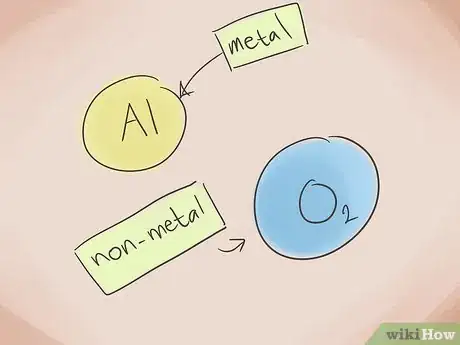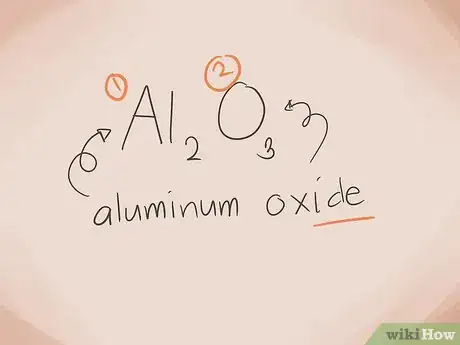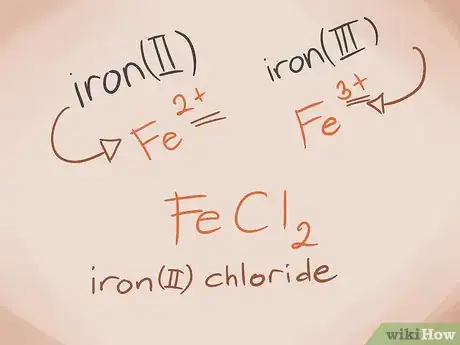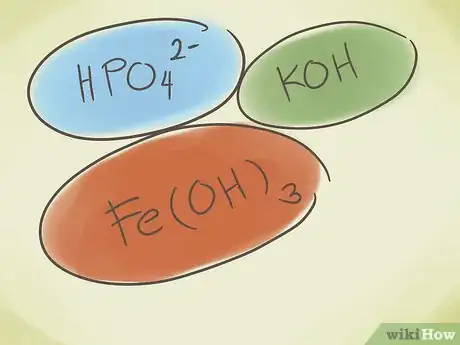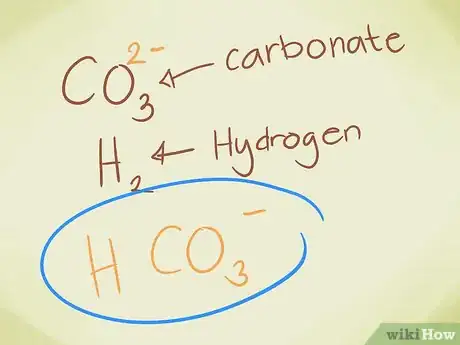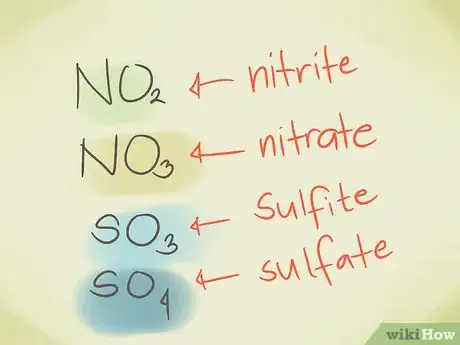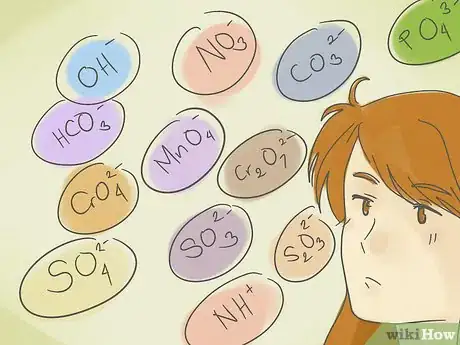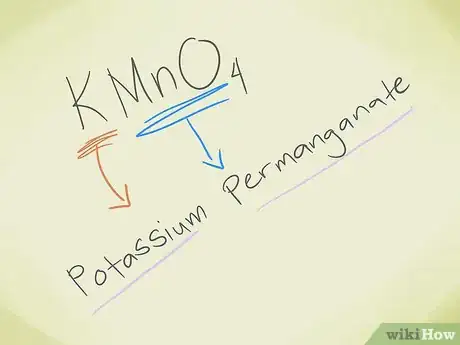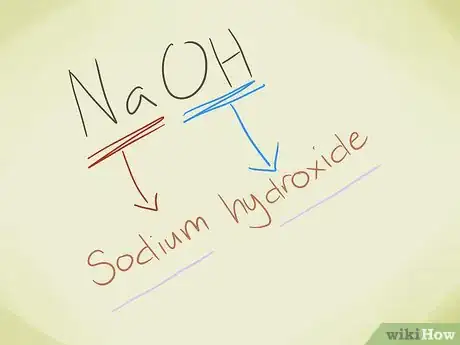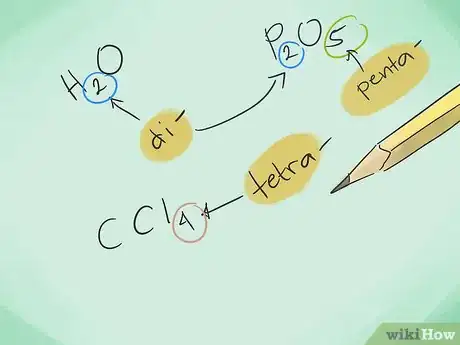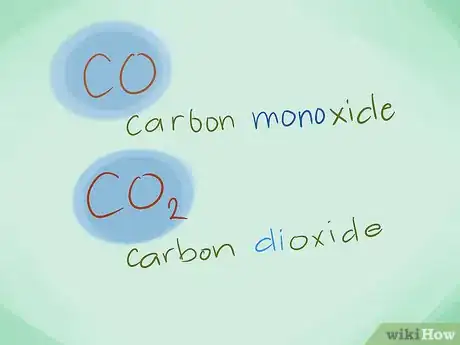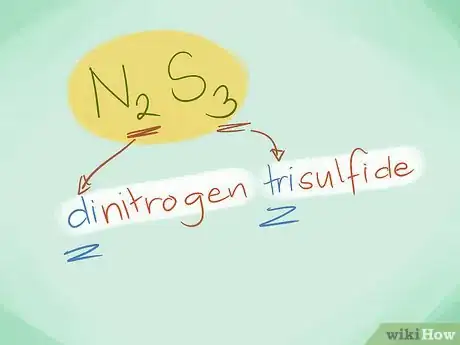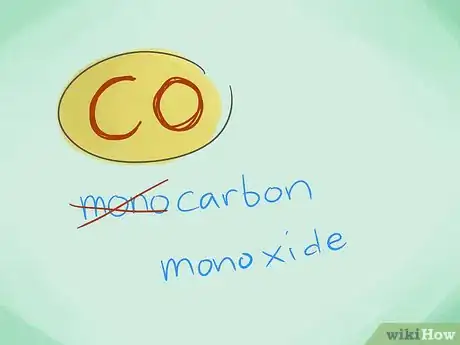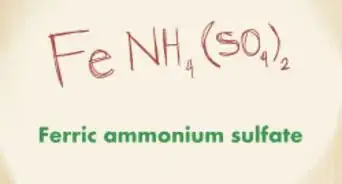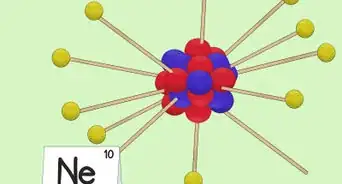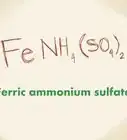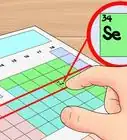This article was co-authored by Bess Ruff, MA. Bess Ruff is a Geography PhD student at Florida State University. She received her MA in Environmental Science and Management from the University of California, Santa Barbara in 2016. She has conducted survey work for marine spatial planning projects in the Caribbean and provided research support as a graduate fellow for the Sustainable Fisheries Group.
wikiHow marks an article as reader-approved once it receives enough positive feedback. This article received 14 testimonials and 84% of readers who voted found it helpful, earning it our reader-approved status.
This article has been viewed 612,349 times.
Naming basic chemical compounds is essential if you want to succeed in chemistry, since the name of the compound clearly defines what it is. Each type of compound has its own rules for naming it. When naming compounds, you need to understand these different rules, as well as how to spot clues that will help you properly name the compounds. Follow this guide for some basic rules on how chemical compounds get their name, and how to apply names to compounds you are unfamiliar with.
Steps
Naming Ionic Compounds
-
1Know what makes a compound ionic. Ionic compounds contain a metal and a nonmetal. Refer to the periodic table of elements to see what categories the elements in the compound belong to.[1]
-
2Build the name. For a two element ionic compound, the naming is simple. The first part of the name is the name of the metal element. The second part is the name of the nonmetal element, with the suffix “-ide.”[2]
- Here are some examples:
- Al2O3. Al2 = Aluminium; O3 = Oxygen. So the name would be “aluminium oxide.”
- FeCl3. Fe = Iron; Cl3 = Chlorine. So the name would be "iron chloride."
- SnO2. Sn = Tin; O2 = Oxygen. So the name of this compound would be Tin Oxide.
Advertisement - Here are some examples:
-
3Recognize and name transition metals. Metals in the D and F blocks of the periodic table are known as transition metals. Their charge is written with a Roman numeral when writing out the compound name. This is because they can have more than one charge and make more than one compound.[3]
- Example: FeCl2 and FeCl3. Fe = Iron; Cl2 = Chloride -2; Cl3 = Chloride -3. The names would be iron(II) chloride and iron(III) chloride.
Naming Polyatomic Compounds
-
1Understand what a polyatomic compound is. These compounds are built off of groups of atoms that are covalently bonded together, and the entire group has a positive or negative charge.[4] You can do three basic things to polyatomic compounds, which will help you identify and understand these types of compounds:
- Add a hydrogen to the beginning of the compound. The word “hydrogen” is added to the beginning of the compound name. This reduces the negative charge by one. For example, “carbonate” CO32- becomes “hydrogen carbonate” HCO3-.
- Remove an oxygen from the compound. The charge stays the same and the ending of the compound changes from “-ate” to “–ite”. For example: NO3 to NO2 goes from “nitrate” to “nitrite.”
- Replace the central atom with another from the same periodic group. For example, sulfate SO42- can become Selenate SeO42-.
-
2Memorize the most common ion groups. These are the basis for forming most polyatomic compounds.[5] Listed in order of increasing negative charge, they are:
- Hydroxide ion: OH-
- Nitrate ion: NO3-
- Hydrogen carbonate ion: HCO3-
- Permanganate ion: MnO4-
- Carbonate ion: CO32-
- Chromate ion: CrO42-
- Dichromate ion: Cr2O72-
- Sulfate ion: SO42-
- Sulphite ion: SO32-
- Thiosulfate ion: S2O3<2-
- Phosphate ion: PO43-
- Ammonium ion: NH4+
-
3Build compound names based off the list. Associate whatever element(s) is attached to the group ion and name accordingly. If the element comes in front of the ion group, the name of the element is simply added to the beginning of the compound name.[6]
- Example: KMnO4. You should recognize the MnO4- ion as permanganate. K is potassium, so the compound is named potassium permanganate.
- Example: NaOH. You should recognize the OH- ion as hydroxide. Na is sodium, so the compound is named sodium hydroxide.
Naming Covalent Compounds
-
1Understand a covalent compound. Covalent compounds are formed by two or more nonmetal elements. The name for the compound is based off how many atoms are present. The prefix attached is the Latin term for the number of molecules.[7]
-
2Learn the prefixes. Memorize the prefixes for up to 10 atoms:[8]
- 1 atom – “Mono-“
- 2 atoms – “Di-“
- 3 atoms – “Tri-“
- 4 atoms – “Tetra-“
- 5 atoms – “Penta-“
- 6 atoms – “Hexa-“
- 7 atoms – “Hepta-“
- 8 atoms – “Octa-“
- 9 atoms – “Nona-“
- 10 atoms – “Deca-“
-
3Name the compounds. Using the correct prefixes, name the new compound. You attach prefixes to any part of the compound that has multiple atoms.[9]
- Example: CO would be carbon monoxide and CO2 would be carbon dioxide.
- Example: N2S3 would be Dinitrogen trisulfide.
- In most cases, the “mono-“ prefix can be omitted, because it is implied when it is not present. It is still used for carbon monoxide due to the term being in use since early chemistry.
Community Q&A
-
QuestionWhat is the difference between ionic compounds and covalent compounds?
 Community AnswerIonic compounds occur between metals and non-metals. They exchange charges and end up with opposite ones. Covalent compounds occur between non-metals. They end up sharing the charges.
Community AnswerIonic compounds occur between metals and non-metals. They exchange charges and end up with opposite ones. Covalent compounds occur between non-metals. They end up sharing the charges. -
QuestionHow do you name things like sulfuric acid and the other acids? How can you tell their formula based on the name?
 Community AnswerThere are two types of acids: those that contain oxygen, and those that do not. If they do not contain oxygen, take the name of the anion, add the prefix hydro, and end with -ic (then add "acid"). Example: HF, hydroflouric acid. To name acids with oxygen, find the name of the polyatomic ion, then change "-ate" to "-ic" or "-ite" to "-ous."
Community AnswerThere are two types of acids: those that contain oxygen, and those that do not. If they do not contain oxygen, take the name of the anion, add the prefix hydro, and end with -ic (then add "acid"). Example: HF, hydroflouric acid. To name acids with oxygen, find the name of the polyatomic ion, then change "-ate" to "-ic" or "-ite" to "-ous." -
QuestionHow do I identify elements of a compound that ends with -ate? For example, how do I know that carbonate is comprised of 1 Carbon and 3 oxygen atoms?
 Community AnswerYou have to memorize the common polyatomic compounds, like chromate ion and others.
Community AnswerYou have to memorize the common polyatomic compounds, like chromate ion and others.
References
- ↑ https://www.angelo.edu/faculty/kboudrea/general/formulas_nomenclature/Formulas_&_Nomenclature.pdf
- ↑ https://www.angelo.edu/faculty/kboudrea/general/formulas_nomenclature/Formulas_&_Nomenclature.pdf
- ↑ https://www.angelo.edu/faculty/kboudrea/general/formulas_nomenclature/Formulas_&_Nomenclature.pdf
- ↑ https://www.khanacademy.org/science/chemistry/atomic-structure-and-properties/names-and-formulas-of-ionic-compounds/a/polyatomic-ions
- ↑ https://www.sciencegeek.net/APchemistry/APpdfs/CommonIons.pdf
- ↑ https://home.miracosta.edu/dlr/names.htm
- ↑ https://chem.libretexts.org/Bookshelves/General_Chemistry/Book%3A_Chemistry_(Averill_and_Eldredge)/03%3A_Chemical_Reactions/3.6%3A_Naming_Covalent_Compounds
- ↑ https://chem.libretexts.org/Bookshelves/Introductory_Chemistry/Basics_of_General_Organic_and_Biological_Chemistry_(Ball_et_al.)/04%3A_Covalent_Bonding_and_Simple_Molecular_Compounds/4.02%3A_Covalent_Compounds_-_Formulas_and_Names
- ↑ https://chem.libretexts.org/Bookshelves/Introductory_Chemistry/Basics_of_General_Organic_and_Biological_Chemistry_(Ball_et_al.)/04%3A_Covalent_Bonding_and_Simple_Molecular_Compounds/4.02%3A_Covalent_Compounds_-_Formulas_and_Names
About This Article
To name chemical compounds, first determine whether the compound is ionic, polyatomic, or covalent. If it is ionic, list the metal element first and then add the nonmetal element with the suffix “-ide.” This should result in a name like "aluminum oxide." To name covalent compounds, first memorize the prefixes that are used to indicate the number of atoms. For example, when there are 2 atoms, use the prefix "di" and before naming the rest of the compound. To learn how to name polyatomic compounds, read on!
